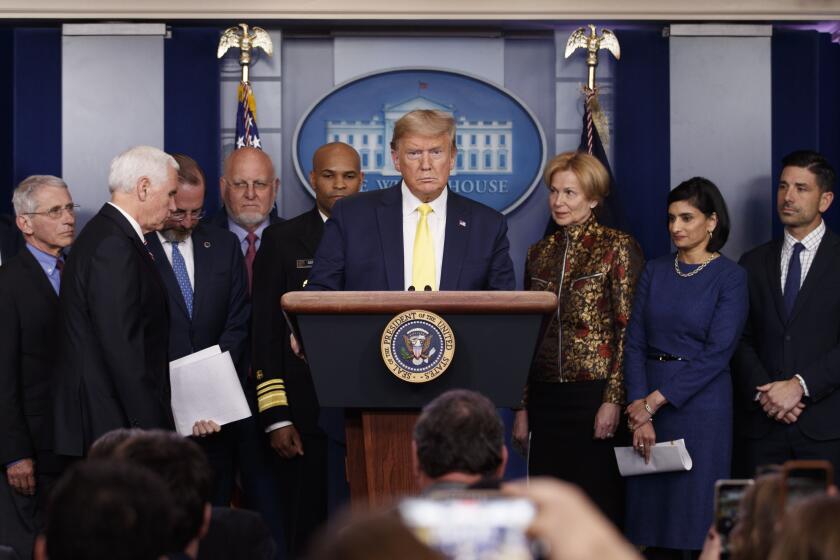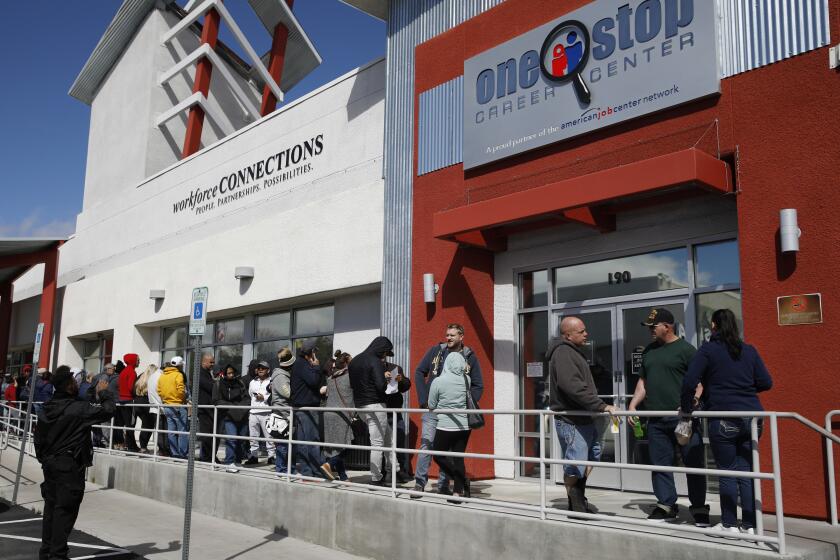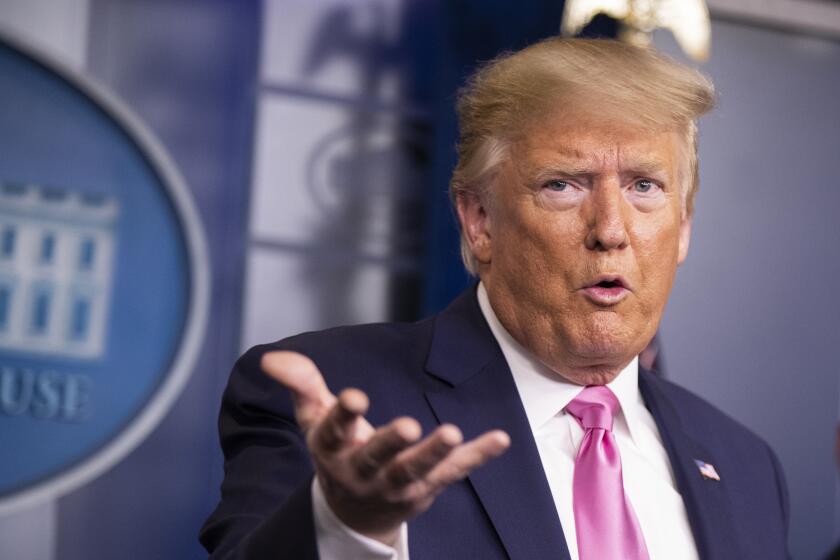Column: Nixon wanted to take credit for government checks too, but a top official stopped him
The report that government assistance for Americans will be delayed because President Trump demanded that his signature appear on the checks reminds us of a previous president’s attempt to do something similar — until it was blocked by an independent-minded government official.
The year was 1972. The president was Richard Nixon. The program was Social Security. And the man standing firm against an overt politicizing of a government program was Robert Ball, who was so broadly respected that he was known as “Mr. Social Security.”
When Ball threatened to resign over the attempt, Nixon had no choice but to back off.
I think it is possible to push this to a point where Ball would go public and quit, and I don’t personally think it is safe to call his bluff.
— HEW Secretary Elliott Richardson to George Shultz, 1972
Things have changed. Today, the highest echelons of the federal government are occupied by Trump toadies who are willing to delay desperately needed help for millions of Americans to assuage Trump’s most childish demands.
As the Washington Post reports, the appearance of a president’s signature on a government check is unprecedented. His signature has no legal significance, since he’s not an authorized signatory of checks issued by the Internal Revenue Service, which is the official source of stimulus payments amounting to up to $1,200 per adult.
While a good portion of the payments will reach Americans via direct deposit, without Trump’s signature — those payments started appearing in bank accounts Wednesday — recipients without a bank account on file with the IRS will receive checks in the mail. In addition to Trump’s signature, they’ll carry a legally required signature by a Treasury civil servant.
A payroll tax cut was a bad idea in President Obama’s time, and even worse now.
The story of Bob Ball’s confrontation over Nixon’s plan to take credit for Social Security payments comes to us via Ball’s memoir in Social Security Administration files, as retailed in “Robert Ball and the Politics of Social Security,” a 2003 biography by Edward D. Berkowitz.
A few words about Robert M. Ball, who was the face of Social Security for generations of Americans in the postwar years: For nearly five decades he was the program’s “indefatigable champion,” as my colleagues Joel Havemann and Johanna Neuman wrote upon his death in 2008.
Ball joined what became the Social Security Administration in 1939, even before the first check was issued in 1940. With a brief gap in the 1940s, he would remain with the program for the rest of his career. He served as Social Security Commissioner from 1962, when he was named by John F. Kennedy, until 1973, when he retired under Nixon.
During his time at the agency, Ball oversaw a raft of improvements, including expansions of coverage and increases in benefits and the establishment of Social Security’s disability program in 1956.
Even after his retirement he continued to play an indispensable role, including as a member of the Greenspan Commission, which crafted a Social Security rescue plan in 1983 that was signed by Ronald Reagan. Ball founded the National Academy of Social Insurance, the nation’s leading advocacy organization for Social Security and other social assistance programs, in 1986.
As late as 2007, at the age of 93, Ball was still defending the program and offering proposals for solidifying its fiscal condition.
As Social Security Administration historians observe, “he adamantly opposed cutting benefits, and indeed suggested benefits should be increased given that only 20 percent of the workforce had traditional pension guarantees, the vagaries of the 401(k) investments that had replaced the traditional pension scheme, the extremely low savings rate among Americans, and the dependence of the majority of the elderly and the disabled on Social Security benefits as a major part of their income.”
It’s time to think about how to get workers raises over the long term.
He wrote then, “Social Security benefits are modest by any measure and are already being cut — by raising the age of eligibility for full benefits and by deducting ever-rising Medicare premiums from benefit checks. ...To cut them further would undermine all that Social Security has achieved — exposing millions of vulnerable people, both elderly and disabled, to needless economic hardship.”
Ball proposed raising the payroll tax so it would cover 90% of wages (the level is now in the mid-80s), turning the estate tax into a dedicated Social Security tax and investing a portion of Social Security’s assets in stocks. None of those changes has been made, but they’re all still worth considering.
That brings us to the Nixon affair. In part thanks to Ball’s efforts, Congress had passed a 20% increase in Social Security benefits in 1972, effective Sept. 1 and therefore scheduled to appear in checks in October. Nixon took credit for the increase, which he claimed “fulfilled a request which I have been making since the first months of my administration.”
What concerned Ball was Nixon’s plan to place his stamp on the increased checks by enclosing inserts, known as “stuffers,” in every envelope.
Stuffers traditionally were strictly informational. If they concerned an increase, that was described in legalistic terms as the product of congressional and presidential action. “No President or congressman got mentioned by name,” Berkowitz reports.
With borrowing rates this low, the U.S. government should borrow and build to combat the novel coronavirus.
Nixon, however, intended to turn the stuffers into a campaign message claiming personal credit for the increase. Coming in October, the timing would serve his 1972 reelection campaign. As conceived by White House counsel Chuck Colson, the stuffers would be colored red, white and blue, carry quotations from Nixon’s speeches, and be marked with Nixon’s signature.
Ball complained to Elliott Richardson, then the secretary of Health, Education and Welfare, that the stuffer would politicize Social Security in the heat of an election campaign. He warned that the plot would backfire, since it might goad Congress into passing retaliatory legislation.
Richardson, in his own memoir (“The Creative Balance,” 1976), recalls that the stuffer was “where Ball, with my strong support, drew the line.”
When Richardson asked how Congress would find out about it, Ball replied, archly, “I don’t see how this could be kept quiet. I’m not saying it would happen, but people thinking truly politically should keep it in mind.”
He also hinted that he would resign over the stuffer. Richardson warned George Shultz, the Treasury secretary, that the White House should tread carefully: “I think it is possible to push this to a point where Ball would go public and quit, and I don’t personally think it is safe to call his bluff.”
Ball’s resignation, he said, would be a political bombshell, timed for maximum devastation.
In the end, the White House abandoned the plan. As Berkowitz reports, “the notices went out with the traditional impersonal language about a benefit increase.”
But that comes off today as ancient history. Figures with Ball’s determination and courage are thin on the ground in the current administration and throughout the executive branch. The absence of someone like him is felt dearly with every day that passes.
More to Read
Inside the business of entertainment
The Wide Shot brings you news, analysis and insights on everything from streaming wars to production — and what it all means for the future.
You may occasionally receive promotional content from the Los Angeles Times.














